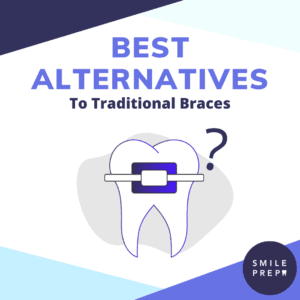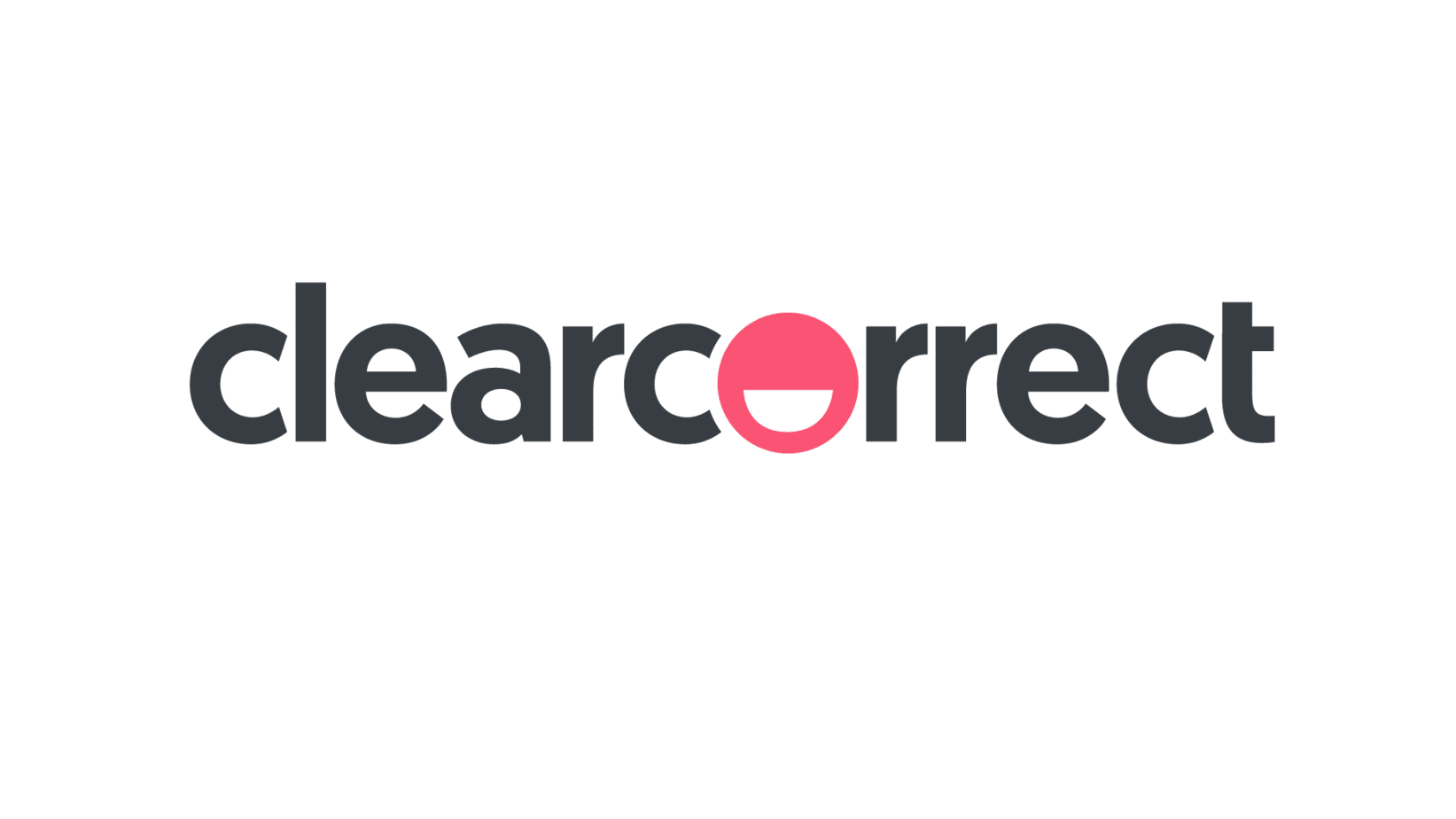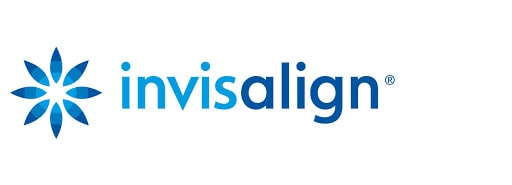
Braces have been around forever, and for good reason: they work. Using metal brackets and wires, they slowly and steadily shift your teeth into place. For many children, it was a rite of passage to show up at school with braces. While they’re incredibly powerful, many adults shy away from brackets and wires, especially if they’ve got work, social gatherings, and dates to attend.
But if not braces, then what? Fortunately, today’s orthodontic and teledentistry technology has opened avenues to new teeth-straightening options. This guide will help you find the one that best fits your condition, timeframe, budget, and priorities.
Table of Contents
Braces vs. Clear Aligners
In the late 1990s, Invisalign shook up the orthodontic industry by releasing the first mass-market clear aligners — plastic trays that could perform similar functions to braces without all the metal. Since then, clear aligners have been a popular treatment option, especially among adults.
Unlike brackets that are affixed to your teeth, clear aligners are removable. You receive an entire series and move from one to the next every few weeks. They’re a lot less noticeable, but they’re also susceptible to human error. If you don’t wear them for 22+ hours per day, your teeth will take longer to shift. Braces and Invisalign both require regular office visits to assess your progress and make any necessary adjustments.
Braces can handle just about any teeth and jaw misalignments you throw at them, but so can clear aligners like Invisalign, which can incorporate attachments (like elastics) to induce more complex movements.
In-Office vs. At-Home Treatment
Recently, companies like SmileDirectClub have developed methods for administering clear aligner treatment from home. They use teams of licensed dentists and orthodontists to design treatment plans and aligners, then oversee each patient’s treatment remotely.
By subtracting office visits from the equation, home aligner companies have made treatment cheaper and more convenient. But without in-person oversight and the option for dental attachments, at-home aligners can treat a narrower scope of conditions, primarily mild-to-moderate cases of crowding and spacing.
First, we’ll take you through the best at-home alternatives to braces, then we’ll discuss the best traditional options.
How we Select and Review Clear Aligner Companies
Smile Prep has reviewed a total of 12 clear aligner brands in-depth. Review candidates include not only the most popular brands, but also several lesser known options that, in our view, have something unique to offer.
Smile Prep’s reviews offer the perspective of a well-informed consumer. This means that our views are not professional opinions, and we do not independently verify the claims the manufacturers make about their products. Instead, the value that we offer is to collect the claims that clear aligner companies make about their products and compare them for your convenience. We also analyze customer perspectives, including hundreds of reviews that we gathered directly from Smile Prep’s visitors. In many cases, we have also corresponded directly with company representatives and/or sampled products or impression kits first hand. You can learn more about our review process by checking out our publishing principles.
Best At-Home Alternatives to Braces
If you’re already sold on at-home aligner treatment and you’ve got a mild-to-moderate case of crowding or spacing, you’ll need to navigate the pros and cons of several different companies to find the best fit. Good news: we’ve ranked and reviewed our top choices right here.
Byte
Since their start in 2018, Byte has used innovative technology to deliver reliable aligner treatments. They advertise an average treatment plan length of 4–5 months, plus they offer personalized customer service, competitive pricing, and accessible financing. They’re always looking for ways to better craft and develop your aligners, and they do it at a much lower price than in-office treatments like braces.
Pros
- Byte’s high-frequency vibration device, the “HyperByte,” helps provide a more comfortable aligner fit (according to the company). Plus, certain studies reviewed by our non-clinical team suggest that devices like this might encourage faster dental shifts. Byte includes this device in the cost of their aligner bundle.
- The Byte for Life guarantee covers your new smile for a lifetime. Even if your teeth shift years down the road, they will create new aligners to readjust them, as long as you’ve been purchasing retainers every six months and wearing them consistently.
- Every Byte customer can receive financing for their aligner treatment, regardless of credit score. Many orthodontic offices have their own financing plans for braces, but they might require credit checks.
- Byte’s dental team consists of dentists and orthodontists, but they guarantee that an orthodontist will be involved in every treatment.
- If you’d rather not wear your aligners 22+ hours per day, Byte offers a nighttime-only treatment schedule that only requires ten hours per day.
Cons
- They don’t offer any physical locations, so to get started, you’ll need to take impressions of your teeth on your own, which can sometimes be difficult.
- Braces can treat a much wider scope of conditions than Byte, including complex bite issues.
- Byte doesn’t require any in-person or virtual check-ins throughout treatment, while braces involve robust oversight via regular office visits.
Considering Byte?
If you’re looking to correct a mild misalignment without breaking the bank or making regular trips to the dentist—but don’t want to sacrifice quality or customer support—we think Byte is the best at-home option.
Special Offer: Save 80% off your impression kit + $100 of your treatment + free BrightByte Pro whitening
SmileDirectClub
Pros
- SmileShops allow you to skip the impression kit and get started with your treatment quickly and easily. Plus, they have a network of 1,000+ dentist’s offices where you can start your treatment with a teeth scan.
- SmileDirectClub’s $2,250 price tag might be higher than some at-home competitors, but it’s much more affordable than braces.
- Like Byte, they offer Nighttime Aligners, which you’ll only need to wear while you sleep instead of the 22 hours per day required by other clear aligners.
- SmileDirectClub provides financing and payment plans to every customer, no credit check required. Financing plans for braces can vary depending on your specific provider.
- They offer prorated refunds for unused and unopened aligners at any time during treatment. And afterward, their Lifetime Smile Guarantee covers your smile for life — as long as you purchase new retainers every six months and wear them as advised.
Cons
- Similar to other home aligner treatments, SmileDirectClub can’t treat the same scope of conditions that braces can. They’re limited to mild and moderate cases of crowding and spacing.
- SmileDirectClub’s support has received a mixed bag of customer feedback over the years. With braces, you can take your questions and concerns directly to your dentist and get an immediate, personalized response.
- During treatment, SmileDirectClub requires virtual check-ins every 90 days, which is less often than you’d go in for office visits with braces.
NewSmile
NewSmile is one of the youngest companies on the list, but also one of the most intriguing. They made their debut in Canada in early 2020, then began selling aligners in the U.S. shortly after. In those few short years, NewSmile’s low price, remote oversight, interest-free financing, and satisfaction guarantee have already made waves. It still has some room for growth, but it’s already a solid option.
Pros
- NewSmile’s $1,595 price tag is one of the lowest in the industry. Not only does it save you thousands when compared to braces and in-office aligners, but it is lower than most of their at-home competitors.
- For that price, NewSmile includes your impression kit, retainers, and whitening kit. That’s a couple of hundred dollars’ worth of bonus products, and once you factor them in, NewSmile beats out AlignerCo.
- Claiming a 4–6-month average timeline, NewSmile is much faster than braces. Just keep in mind it’s often because NewSmile takes on much milder cases.
- NewSmile also offers a nighttime-only treatment, which only requires you to wear your aligners for ten hours a day, mostly while you sleep.
- Throughout NewSmile treatment, you’ll upload videos of your teeth to their app every two weeks, helping keep your treatment on track.
Cons
- NewSmile doesn’t have any retail locations for in-office teeth scans. The at-home impression kits they provide can be difficult, so not having an alternative is a little disappointing.
- There aren’t many reviews of NewSmile’s services available on reputable third-party websites. While most of that feedback is positive, we would feel better with more reviews to evaluate.
- NewSmile’s remote oversight is more frequent than going to office visits every 4–6 weeks, but it’s less robust.
AlignerCo
Home teeth aligners are already fairly affordable, but AlignerCo takes it to the next level, offering the industry’s lowest sticker price and multiple financing plans that make their treatment widely accessible.
AlignerCo doesn’t quite have the same level of convenience as some other providers, but their low price makes up for it.
Pros
- AlignerCo’s sticker price is $995. That’s hundreds less than any other home aligner company and thousands less than braces.
- They don’t require a credit check for their SmileFlex Easy financing plan, so everyone qualifies (their standard SmileFlex plan requires a soft credit check).
- They frequently run sales and promotions that take their prices even lower.
- AlignerCo requires you to submit photos of your teeth via email every two weeks, so their dental team will consistently monitor your progress.
- AlignerCo says their treatment typically takes 4–6 months, which is about average for at-home aligners, but still faster than braces.
Cons
- AlignerCo only has one physical location, and it doesn’t offer teeth scans, so most customers will need to purchase and use an impression kit.
- While AlignerCo’s remote oversight helps keep you on track, it’s not as robust as the regular hands-on care you’ll receive from in-office treatments.
- While many at-home aligner companies offer satisfaction guarantees, free refinements, refunds, or lifetime guarantees, AlignerCo does not.
Thinking about AlignerCo?
On a tight budget? AlignerCo might not have the pedigree of quality that Byte and SmileDirectClub do, but you can’t beat their low prices.
Special Offer: Get $150 off AlignerCo treatment
Best In-Office Alternatives to Braces
Maybe you like the reassurance that comes with in-person dentist oversight. Or you might prefer a more time-tested treatment method. Either way, these in-office alternatives give you the reassurance of hands-on care without the metal brackets and wires.
Candid
Candid straddles the line between at-home and in-office care, requiring at least one office visit with a local dentist and incorporating intensive remote monitoring. Their treatment plans are more comprehensive than at-home clear aligners, and they keep your dentist in the loop throughout the entire process, even recommending additional office visits if any issues arise.
Pros
- Candid’s average treatment time is 6–9 months, while braces can take two years or more.
- At $3,500+, Candid is often less expensive than braces, although it depends on your dentist’s location and rates.
- After the initial office visit, your dentist and Candid’s team monitor your progress remotely — a more streamlined process than braces, which require office visits every few weeks.
- Using their CandidMonitoring service, you’ll send digital scans of your teeth to your dentist and Candid’s team every 14 days so they can evaluate your progress, assess any issues, and make adjustments if necessary.
- Just like braces, Candid’s treatment plans can move all the teeth in your dental arches, including the molars, when necessary. This makes them a more comprehensive option than fully at-home options.
Cons
- Candid treatment is designed to correct mild and moderate misalignments, so it’s not typically viable for severe conditions like braces are.
- Candid has only 300+ network providers across the U.S., while you can get braces at just about any orthodontist.
ClearCorrect
ClearCorrect is fairly comparable to Invisalign, and both are respectable braces alternatives. If you choose ClearCorrect, your dentist or orthodontist will scan your teeth, create your aligner plan, and administer the aligners in-office. You’ll need to schedule appointments every 4–6 weeks so that they can keep track of your progress and make adjustments, if necessary.
Founded in 2006, ClearCorrect hasn’t been around as long as braces or Invisalign, but they’ve still been delivering quality results for over a decade and offer a comparable experience that can be, in some cases, even more cost-effective.
Pros
- ClearCorrect charges dentists/orthodontists less for products and lab fees, and this might lead to lower costs for you as well.
- ClearCorrect aligners use a thinner plastic than other aligners, which can make them less visible (but might also affect their durability).
- ClearCorrect’s direct dentist oversight allows them to treat a variety of severe conditions, including bite issues like overbite, underbite, etc.
- On average, ClearCorrect is faster than braces, with typical treatment times that fall in the 12–18 month range.
- ClearCorrect offers different treatment options and prices, depending on the severity of your case, so you won’t pay more than you need to.
Cons
- ClearCorrect hasn’t been around as long as other traditional treatments, so they can’t match braces’ extensive résumé.
- ClearCorrect has fewer providers than braces or Invisalign, so it might be harder to find one near you.
SureSmile
SureSmile is one of the oldest clear aligner companies on the market. They got their start making intuitive archwires for lingual braces before releasing aligners in 2007. Their aligners often cost less than Invisalign, they give dentists more ways to customize your treatment, and they don’t force doctors to use a specific intraoral scanner, making their treatment more accessible.
Pros
- SureSmile is one of the most affordable in-office clear aligner treatments. With a price range of $2,000–$6,000, they’re sometimes on par with at-home aligners for mild cases.
- SureSmile’s planning software gives the doctor a lot of control over even the smallest elements of aligner design, so it’s less likely that you’ll need refinements after treatment.
- They have two plans: Complete and Select. Select lets you pay per aligner, so if you have a mild alignment concern, you can save a lot of money.
- Your doctor can customize the cut of your aligners based on your unique case. Other clear aligner brands either use a “straight” or “scalloped” cut across the board.
Cons
- SureSmile hasn’t been around as long as braces or Invisalign, and isn’t as widely available, so you might struggle a bit to find a provider near you.
- SureSmile’s materials, while solid, are considered less durable than braces or Invisalign’s SmartTrack plastic.
3M Clarity Aligners
When we say “orthodontic treatment,” 3M probably isn’t the first name that comes to mind — but maybe it should be. Their Clarity Aligners offer incredible teeth-moving power thanks to their unique attachment placement. And because they also produce Clarity Clear Braces, they can offer combination treatment for the limited number of cases their aligners cannot address on their own.
Pros
- Clarity Aligners aren’t the only ones that use attachments, but they use them uniquely. Sometimes, orthodontists will place them behind your teeth rather than in front, helping to keep your treatment discreet. They can also accommodate multiple attachments per tooth, facilitating more complex movements.
- Most companies use a single type of plastic in their aligners, but 3M Clarity uses two, each with its own unique strengths and applications. Your orthodontist can select one or the other, or alternate between plastics for different stages of treatment.
- While they are very durable, the aligners are thinner than most. This avoids irritation of the soft tissues and reduces visibility, both of which gives them a solid edge over braces.
- Clarity uses the same planning software for their aligners and their clear braces, allowing for integrated planning of combination treatment — something other companies don’t offer.
Cons
- Most clear aligners aim to undercut the prices of Invisalign and braces. 3M Clarity doesn’t, which means you’ll pay around $5,000 on average for treatment.
- Clarity Aligners patients have to be at least 13 or older and not have any remaining baby teeth. While this won’t matter for adult patients, those looking for treatment for their kids might need to find another option.
Invisalign
They’re the original clear aligner and the first company to present a successful alternative to braces. As a result, their popularity skyrocketed. With over 20 years of results and innovation, they’re still a popular orthodontic option. They can treat almost all the same conditions as braces, but they’re much more discreet (and removable).
If you want a less noticeable treatment, Invisalign is a great option. The downside is that they can be pricier and more time-consuming than remote options — and even some other in-office aligners.
Pros
- Invisalign can incorporate attachments (like buttons and elastics) that allow it to treat a wide range of severe conditions, even bite issues.
- On average, Invisalign treatment takes 12–18 months, so they can be faster than braces.
- Candid treatment uses industry-leading technology, like their SmartTrack plastic, iTero scanners, and ClinCheck software. Candid providers might use similar tech, but they might also use inferior alternatives.
- Invisalign has over 40,000 providers in the US, far more than any other clear aligner producer, which makes their treatment more widely accessible than other in-office clear aligners.
- Invisalign also offers Invisalign Express, as an expedited treatment option that only requires about six months to complete.
- Founded in 1997, Invisalign has a long track record of successful smile transformations, so you can be confident in their methods.
Cons
- Invisalign can be more expensive than other treatments, sometimes as high as $8,000 depending on your condition, dentist, and location.
- Like other clear aligners, Invisalign leaves room for user error, like failing to wear them for 22+ hours a day. Braces are always on your teeth, so they don’t present the same concern.
So, Which Should I Choose?
We realize that it’s not an easy decision, especially because you have so many good options. In the end, it’s important to consider your priorities. Are you on a tight budget? Do you want the shortest treatment possible? Or do you want the most thorough treatment, regardless of cost or timeframe? This table will help you quickly compare your options.
| Provider | Can Treat | Advertised Average Treatment Plan | Price |
|---|---|---|---|
| Braces | Mild-to-severe cases | 18–24 months | $5,000 (average) |
| Invisalign | Mild-to-severe cases | 12–18 months | $5,000 (average) |
| Byte | Mild-to-moderate cases | 4–5 months (5–6 months for Byte at Night) | $2,099 |
| Candid | Mild-to-moderate cases | 6–9 months | $3,500+ (average) |
| SmileDirectClub | Mild-to-moderate cases | 4–6 months (10 months for Nighttime Aligners) | $2,250 |
| NewSmile | Mild-to-moderate cases | 4–6 months | $1,595 |
| AlignerCo | Mild-to-moderate cases | 4–6 months (6–8 months for NightOnly Aligners) | $995 |
| ClearCorrect | Mild-to-severe cases | 12–18 months | $3,000 (average) |
| 3M Clarity Aligners | Mild-to-severe cases | 6–24 months | $5,000 (average) |
| SureSmile | Mild-to-severe cases | 6–18 months | $4,000 (average) |
First, you should decide whether you want in-office or at-home treatment. Weigh the pros and cons of each one to see which might be better for your unique condition and circumstances. If you have a severe condition that requires traditional care, ClearCorrect, SureSmile, 3M Clarity, and Invisalign are great options. If you simply have a mild-to-moderate case of crowding or spacing, we think an at-home provider like Byte is worth considering.
Byte: Our #1-Recommended Braces Alternative
Byte is the #1 braces alternative we recommend for most users. We think their fast treatment times for many customers, fair price point, and high-quality customer support make them worth considering for anyone with a mild-to-moderate dental misalignment.
If you decide Byte is the right treatment option for you, be sure to take advantage of this special promotion. Byte is currently offering its impression kit for just $17.95 ($80 off its list price). In addition, as part of this offer Byte will include with your impression kit a free whitening pen to help you brighten your teeth on the go. Enter the code SMILEBRYTE at checkout to claim this promotion.
Final Thoughts
Braces are still a great teeth-straightening option. But they’re not for everyone. If wearing metal brackets in public will stress you out, there are plenty of other treatments to consider. Before choosing one, thoroughly evaluate your personal priorities and see how each option measures up. Our site has a lot of useful info, including our guide to the top five home aligner companies, so feel free to explore. Then, you’ll be ready to make a confident, well-informed decision.
Frequently Asked Questions
What is the cheapest alternative to braces?
Invisalign’s biggest drawback is perhaps its high price. If you’re operating on a budget and looking for the most cost-effective alternative, AlignerCo might be your answer (assuming you’re a candidate for home aligner treatment). Their $995 price tag is the lowest available.
That said, any home aligner company is going to offer much lower costs than Invisalign. Check out a few options that won’t break the bank in our review of the Most Affordable Clear Aligners.
What’s the difference between traditional and at-home treatment?
The most noticeable difference is each treatment’s office visit requirements. Traditional treatments like braces and Invisalign require office visits every 4–6 weeks. This provides consistent oversight and allows them to correct more severe conditions. Home aligners, however, ship you all of your aligners at once so that you can administer treatment entirely at home.
They’re still designed by licensed dentists, but you don’t need to make office visits for regular check-ins. The trade-off is that home aligners can only correct mild and moderate cases of crowding and spacing.
How do home aligners work?
Using an impression kit, you’ll submit molds of your teeth (or visit a retail location for a teeth scan). The company’s dental team will use these images to develop a series of custom aligners for your teeth, then ship them directly to your home. Over the next several months (six on average), you’ll wear your aligners every day, changing sets when directed, and your teeth will slowly shift into place.
Are financing plans available?
Yes! Many dentists and orthodontists have their own financing and payment plans, so you’ll want to check with yours to see what they offer. Some home aligner companies offer in-house payment plans that don’t require a credit check, while others partner with a third party to provide financing (these typically require a credit check to qualify).
Which clear aligners are the least noticeable?
This one is tricky, as there’s not a unanimous choice for “least noticeable.” Rather, this category is often defined primarily by personal preferences. Even so, we think AlignerCo and NewSmile make pretty discreet aligners, and Byte, SmileDirectClub, and Candid also provide good options. Take a look at our review of the Best Looking Clear Aligners for more information.
What is the most convenient alternative to braces?
Because they don’t require any office visits and deliver treatments to your doorstep, at-home aligners are often more convenient than in-office options like Invisalign. But among all the home aligner companies, SmileDirectClub stands out for their SmileShop locations and nighttime-only option. In our review of the Most Convenient Clear Aligners, you’ll find a few more companies worth considering.
Does insurance cover clear aligner treatment?
It depends on your provider and plan. Providers are more likely to cover an in-office treatment like Invisalign than home aligners, since home aligners usually address cosmetic issues. Some home aligner companies (like Byte and SmileDirectClub) have partnerships with certain insurance providers.
How much do braces cost?
According to the American Dental Association, the average price for adult braces treatment is $4,800 to $7,135. However, it’s hard to give a specific number because your price is influenced by several factors, including your condition’s severity, your orthodontist’s rates, and even where you live. For an in-depth look at Invisalign pricing (and to see how much it typically costs in each state) see our True Cost of Braces guide.
How long does braces treatment take?
It usually takes somewhere around 18–24 months, but can be shorter or longer depending on the severity of your condition. By comparison, most home aligner companies advertise six-month average treatment times, which is possible because they typically handle milder conditions that don’t take as long to correct.
How do I get started with home aligners?
You’ll need to order an impression kit and create molds of your teeth, then send them to your company of choice. If you go with SmileDirectClub, you can visit one of their physical locations for a free teeth scan, which replaces the impression kit process.
Are home aligners safe?
At-home clear aligner treatment plans are always designed and/or approved by a licensed dentist or orthodontist — as long as you’re buying from a legitimate clear aligner service.
The main concern regarding the safety of fully-remote clear aligner treatment is the lack of face-to-face care. Since you won’t be seeing a dentist in-person during treatment, you won’t receive the same level of support that you’d get with traditional in-office aligners like Invisalign or ClearCorrect. That said, a recent NIH-funded survey found the majority of at-home aligner customers were satisfied with their results, and only 6.6% experienced side effects necessitating a visit to their local dentist.
Read our guide to safe home teeth straightening treatment for more information.
Do clear aligners hurt?
Customers often report experiencing tightness or discomfort during the first 1–2 days wearing a new set of aligners, after which the discomfort subsides. Some companies provide “chewies” or other devices to help ensure a more comfortable aligner fit.









Join The Discussion: